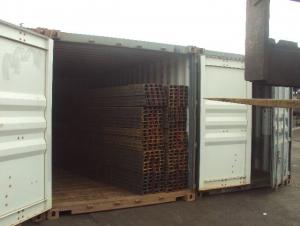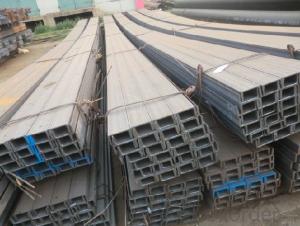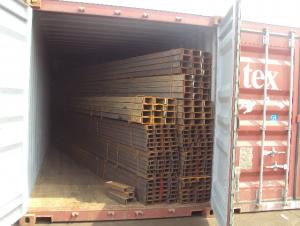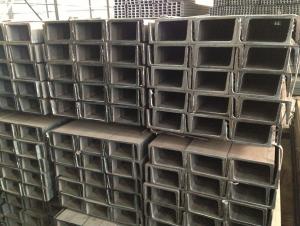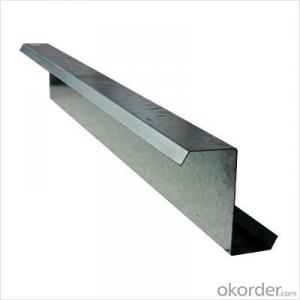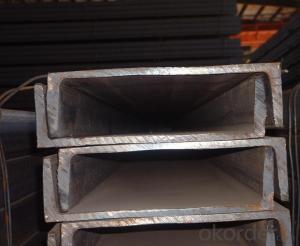U-channel JIS Standard with Different Sizes
- Loading Port:
- Tianjin
- Payment Terms:
- TT or LC
- Min Order Qty:
- 25 m.t.
- Supply Capability:
- 1000 m.t./month
OKorder Service Pledge
OKorder Financial Service
You Might Also Like
Product Description:
OKorder is offering U-channel at great prices with worldwide shipping. Our supplier is a world-class manufacturer of steel, with our products utilized the world over. OKorder annually supplies products to European, North American and Asian markets. We provide quotations within 24 hours of receiving an inquiry and guarantee competitive prices.
Product Applications:
1.The JIS channel can be devided into two kinds, namely common channel steel and light channel steel. The sizes of hot rolled common channel steel range from 5# to 40#. Meanwhile, the channel steel can be divided into cold forming sectional equal channel steel, cold forming sectional unequal channel steel, cold forming inner edge channel steel and outer edge channel steel.
2.The JIS channel is usually used for arch-itechtural structure, and they could be welded in order to support or hang a vari-ety of facilities. They are also usually used in combination with I beam. The channel steel with sizes under 14# is usually applied to construction engineering, as purline, while the channel steel with sizes above 16# is more likely to be used in building vehicle chassis structure and mechanical structure. Furthermore, the channel steel in sizes above 30# are target at building bridge structure, as tension bar.
Product Advantages:
OKorder's U-channel are durable, strong, and resist corrosion.
Main Product Features:
· Premium quality
· Prompt delivery & seaworthy packing (30 days after receiving deposit)
· Corrosion resistance
· Can be recycled and reused
· Mill test certification
· Professional Service
· Competitive pricing
Product Specifications:
1. We are definitely speciallizing in manufacturing and supplying channel steel as per japanese standard, which is characterised with high mechanical strength and competitive prices.
2. The sections in details are as followings in the table-1
JIS CHANNEL | Standard h | Sectional b | Dimension s | t | Mass: Kg/m |
(mm) | (mm) | (mm) | (mm) | ||
50x25 | 50 | 25 | 3.0 | 6.00 | 2.37 |
75X40 | 75 | 40 | 3.8 | 7.00 | 5.30 |
75X40 | 75 | 40 | 4.0 | 7.00 | 5.60 |
75X40 | 75 | 40 | 4.5 | 7.00 | 5.85 |
75X40 | 75 | 40 | 5.0 | 7.00 | 6.92 |
100X50 | 100 | 50 | 3.8 | 6.00 | 7.30 |
100X50 | 100 | 50 | 4.2 | 6.00 | 8.03 |
100X50 | 100 | 50 | 4.5 | 7.50 | 8.97 |
100X50 | 100 | 50 | 5.0 | 7.50 | 9.36 |
125X65 | 125 | 65 | 5.2 | 6.80 | 11.66 |
125X65 | 125 | 65 | 5.3 | 6.80 | 12.17 |
125X65 | 125 | 65 | 5.5 | 8.00 | 12.91 |
125X65 | 125 | 65 | 6.0 | 8.00 | 13.40 |
150x75 | 150 | 75 | 5.5 | 7.30 | 14.66 |
150x75 | 150 | 75 | 5.7 | 10.00 | 16.71 |
150x75 | 150 | 75 | 6.0 | 10.00 | 17.90 |
150x75 | 150 | 75 | 6.5 | 10.00 | 18.60 |
150x75 | 150 | 75 | 6.5 | 10.00 | 24.00 |
200X80 | 200 | 80 | 7.5 | 11.00 | 24.60 |
Packaging & Delivery of U-channel:
Packaging Detail: products are packed in coil, each coil weight around 2 MT, and then shipped by container or bulk vessel
Delivery Detail: within 45 days after received deposit or LC.
Label: to be specified by customer, generally, each bundle has 1-2 labels
Trade terms: FOB, CFR, CIF
FAQ:
Q1: How soon can we receive the product after purchase?
A1: Within three days of placing an order, we will begin production. The specific shipping date is dependent upon international and government factors, but is typically 7 to 10 workdays.
Q2: What makes stainless steel stainless?
A2: Stainless steel must contain at least 10.5 % chromium. It is this element that reacts with the oxygen in the air to form a complex chrome-oxide surface layer that is invisible but strong enough to prevent further oxygen from "staining" (rusting) the surface. Higher levels of chromium and the addition of other alloying elements such as nickel and molybdenum enhance this surface layer and improve the corrosion resistance of the stainless material.
Q3: Can stainless steel rust?
A3: Stainless does not "rust" as you think of regular steel rusting with a red oxide on the surface that flakes off. If you see red rust it is probably due to some iron particles that have contaminated the surface of the stainless steel and it is these iron particles that are rusting. Look at the source of the rusting and see if you can remove it from the surface.
Images:
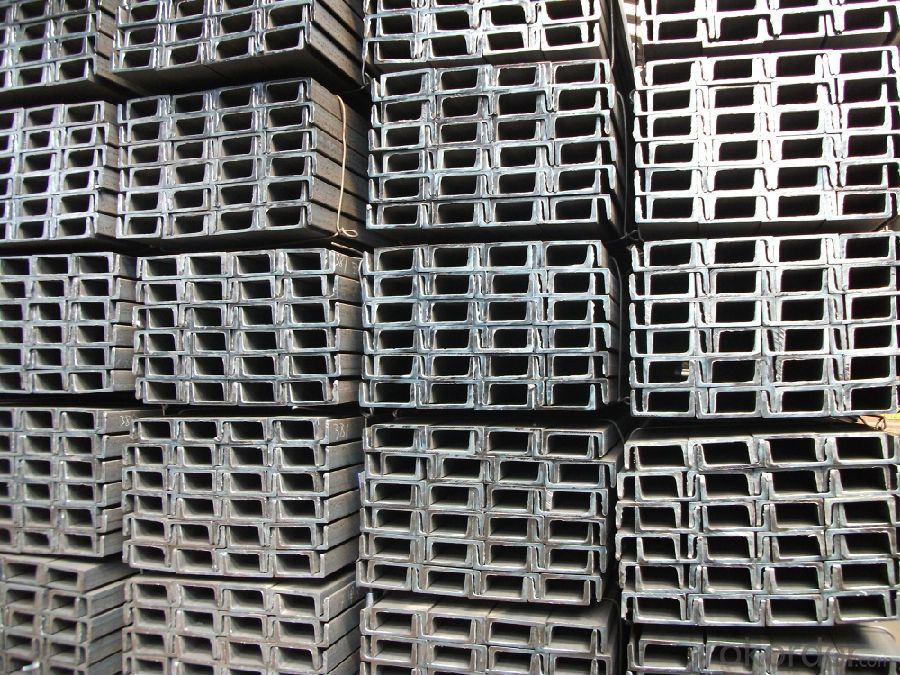
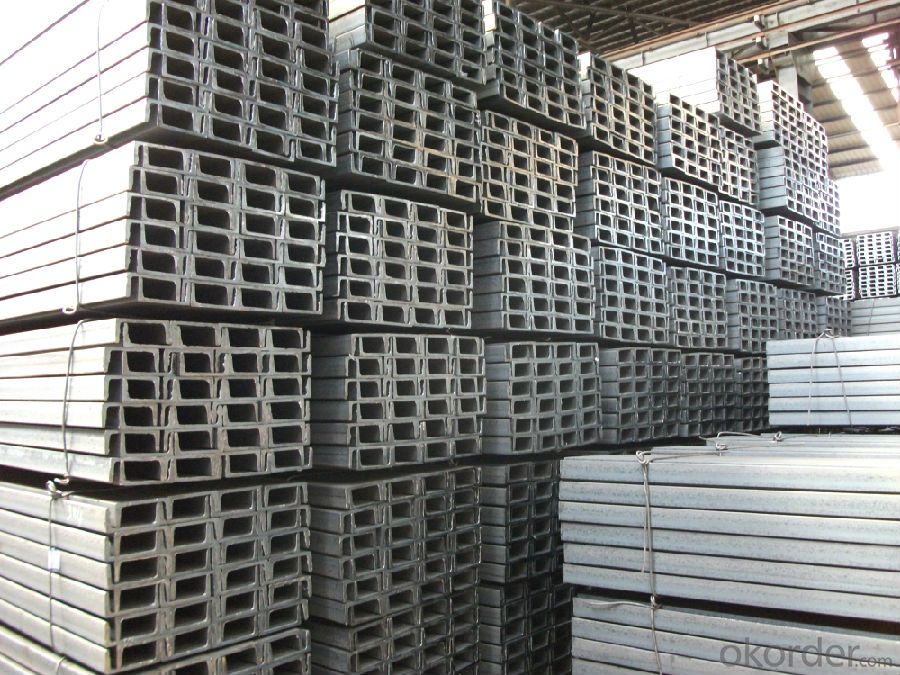
- Q:Are steel channels suitable for indoor recreational facilities?
- Yes, steel channels are suitable for indoor recreational facilities due to their strength, durability, and versatility. They can be used for constructing various structures such as support beams, frames, and partitions, providing stability and safety. Additionally, steel channels are resistant to moisture, corrosion, and fire, making them a reliable choice for recreational facilities.
- Q:Can steel channels be used for storage racks?
- Yes, steel channels can be used for storage racks. Steel channels are commonly used in the construction industry for their strength and durability. They are designed to provide support and stability, making them suitable for storing heavy items such as pallets, boxes, and other bulky goods. Steel channels can be easily assembled and configured to create various rack designs, including selective racks, drive-in racks, and push-back racks. Additionally, steel channels can be galvanized or coated to increase their resistance to corrosion, making them ideal for use in storage facilities where moisture or harsh environments may be present. Overall, steel channels offer a reliable and sturdy solution for storage rack systems.
- Q:What are the different grades of steel used for channels?
- Channels are commonly made from various grades of steel. The choice of steel grade depends on the desired properties and intended application. A36 steel is one grade that is frequently utilized. It is a low carbon steel known for its versatility and excellent weldability. Due to its strength and durability, it is often employed in structural applications, such as channels. Another grade that is commonly used is A572 steel. This is a high-strength, low-alloy steel that offers improved strength and corrosion resistance compared to A36 steel. It is suitable for demanding applications, including heavy-duty construction projects. Additional grades of steel that may be employed for channels include A588 steel, which is known for its corrosion resistance in weathering conditions, and A500 steel, which is a structural steel often used in construction and infrastructure projects. To determine the most suitable grade of steel for a specific channel application, it is important to consult with a structural engineer or steel supplier. Factors such as load-bearing capacity, corrosion resistance, and environmental conditions should be taken into consideration.
- Q:How do steel channels contribute to building envelope performance?
- Steel channels contribute to building envelope performance in several ways. Firstly, they provide structural support, adding stability and strength to the overall structure. This is crucial for withstanding external forces such as wind, snow, and earthquakes. Secondly, steel channels can act as a framework for insulation materials, helping to improve the building's thermal performance by reducing heat transfer. Additionally, they can be used to create air barriers, preventing unwanted air infiltration and enhancing energy efficiency. Finally, steel channels can also support the installation of windows and doors, ensuring proper sealing and weather resistance. Overall, steel channels play a vital role in enhancing the performance and durability of the building envelope.
- Q:How do you calculate the section modulus for steel channels?
- To calculate the section modulus for steel channels, you need to determine the moment of inertia of the cross-sectional shape of the channel, and divide it by the distance from the neutral axis to the outermost fiber of the section. The formula for section modulus (Z) is Z = I / c, where I represents the moment of inertia and c is the distance from the neutral axis to the outermost fiber.
- Q:Large steel channel used for steel structural staircases
- Standard Specification for channel steel is C250*78*6TThe rest are flat steel strips and checkered steel plates
- Q:Are steel channels suitable for DIY projects?
- For DIY projects, steel channels are a suitable option. With their versatility and sturdiness, steel channels are ideal for a range of DIY applications. You can utilize them to construct shelves, workbenches, frames, and supports for different structures. By using steel channels, you can ensure that your DIY project will be strong and long-lasting because of their excellent strength and durability. Moreover, steel channels are easily obtainable in various sizes and lengths, making it effortless to find the right dimensions for your project. Additionally, they are relatively easy to work with, allowing DIY enthusiasts to cut, drill, and weld them as necessary. All things considered, steel channels are an excellent choice for DIY projects, thanks to their strength, versatility, and availability.
- Q:The above four should be all types of steel, but what is the relationship between H steel and I-beam, C section steel and channel steel?Is the I-beam included in the H section, or is it all the same?
- First of all, C steel after cold bending of hot coil and high strength, good tenacity, and channel production can save 30% compared to the same intensity of raw materials, is a direct channel by steel companies, the thickness is greater, it is groove shaped cross section.?Second, C steel is usually used for steel structure building wall beam, beam, bracket or other building components, widely used in the activity room, also can be used in machinery manufacturing industry. Channel steel is mainly used in building structures, vehicle manufacturing, and other industrial structures, often with the use of i-beam. Although the two steels are used in building structures, they are used in different ways.
- Q:What are the corrosion resistance properties of steel channels?
- Steel channels exhibit outstanding corrosion resistance characteristics, rendering them highly suitable for a variety of applications. The primary reason behind the corrosion resistance of steel channels is the existence of a protective oxide layer on their surface, which develops naturally upon exposure to oxygen in the atmosphere. This layer acts as a barrier, effectively preventing any further corrosion. Moreover, the corrosion resistance of steel channels can be further enhanced through the application of additional coatings or treatments. A common method used to protect steel channels from corrosion is galvanization, whereby a layer of zinc is applied to the channels. This zinc layer serves as a sacrificial shield, effectively preventing direct contact between the steel and corrosive elements. In addition, stainless steel channels offer exceptional resistance to corrosion. These channels are composed of an alloy containing a high percentage of chromium, which leads to the formation of a thin, transparent oxide layer on the surface. This oxide layer provides superior protection against corrosion caused by moisture, chemicals, and various environmental factors. On the whole, steel channels possess exemplary corrosion resistance properties, establishing them as a dependable choice for applications where exposure to corrosive elements is a concern. Whether it be through the natural oxide layer, galvanization, or the utilization of stainless steel alloys, steel channels offer long-lasting durability and reliable protection against corrosion.
- Q:Are steel channels cost-effective compared to other materials?
- Steel channels are generally considered to be a cost-effective option when compared to other materials. This is due to the fact that steel is widely available and relatively inexpensive. As a result, steel channels are often chosen for construction and manufacturing projects as they provide good value for money. Not only that, but steel channels also offer exceptional strength and durability, enabling them to withstand heavy loads and harsh conditions. This durability leads to long-term cost savings, as steel channels require less maintenance and replacement compared to alternative materials. Moreover, steel is highly recyclable, making it an environmentally friendly choice. Although the initial cost of steel channels may be slightly higher than some other materials, their long-term cost-effectiveness and numerous benefits make them a popular option in various industries.
1. Manufacturer Overview |
|
|---|---|
| Location | |
| Year Established | |
| Annual Output Value | |
| Main Markets | |
| Company Certifications | |
2. Manufacturer Certificates |
|
|---|---|
| a) Certification Name | |
| Range | |
| Reference | |
| Validity Period | |
3. Manufacturer Capability |
|
|---|---|
| a)Trade Capacity | |
| Nearest Port | |
| Export Percentage | |
| No.of Employees in Trade Department | |
| Language Spoken: | |
| b)Factory Information | |
| Factory Size: | |
| No. of Production Lines | |
| Contract Manufacturing | |
| Product Price Range | |
Send your message to us
U-channel JIS Standard with Different Sizes
- Loading Port:
- Tianjin
- Payment Terms:
- TT or LC
- Min Order Qty:
- 25 m.t.
- Supply Capability:
- 1000 m.t./month
OKorder Service Pledge
OKorder Financial Service
Similar products
New products
Hot products
Hot Searches
Related keywords
